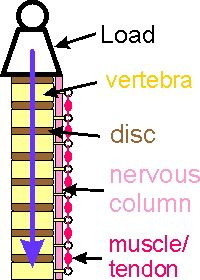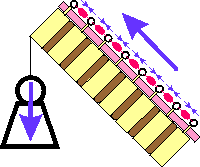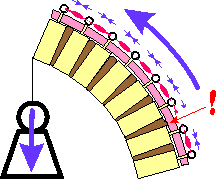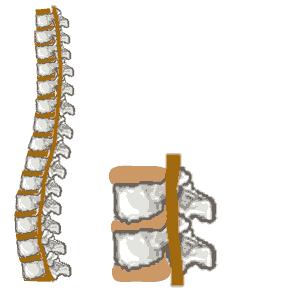|
|
 |
|
 |
This is a simplified diagram of the spine. See that the spine consists
of:
- the vertebrae, solid bones
which have attachments for muscle tendons
- the discs, which are jelly-filled
sacs between the vertebrae; these allow movement and shock-absorbtion
- muscles, and the tendons
which connect them to the vertebrae
- the nervous column (also
called the spinal cord), which connects the brain to the rest
of the body and runs down through the vertebrae, between the discs
and the muscles
|
|
In this first example, the load is carried on top of the spine.
The blue arrow shows how the force tends only to compress
the spine. This means that the discs are evenly loaded and the muscles
and tendons are relaxed. The spine can take big loads safely when
loaded like this.
In this diagram, the spine is leaning over, though in a straight
line. See that the muscles now have to work to stop the spine bending
(muscles can only contract, not expand).
|
 |
This means that the discs are now compressed from below by the
load, AND from above by the contracting muscles. Because the muscles
are very close to the vertebrae, they exert a lot of compressive
force in order to resist the bending. Conversely, even quite a light
load creates enormous tensile forces in the muscles and tendons,
because of the leverage.
So pressure in the discs is very high, because
the weight of the load is magnified many times by the geometry of
bending.
|
| The strain on the muscles and tendons
can be more than they can take without tearing, and stress damage
can accumulate at a rate faster than it can be repaired. This can
lay the foundations of an acute back-pain attack which may be triggered
later by some unrelated and even trivial movement, disguising the
real cause.
This last diagram shows how most of us lift things, and how so
many of us get bad backs. The spine is leaning over and bent, stretching
the muscles and tendons, and squeezing the discs.
|
 |
The squeezing of the discs raises the pressure inside even higher,
reducing their nutrition (which mainly comes through the walls
not through a blood supply), and making them prone to bursting
( a herniated or 'slipped' disc). The escaping bubble of disc wall
can then press on the nervous column creating pain that is often
felt in some other part of the body ('referred pain' called sciatica).
The discs themselves have few nerves, so you can't feel this damage
happening until it's too late.
Herniated discs will normally repair themselves, as long as the
stresses that caused the damage are not being repeated.
|
...................
|
|
|